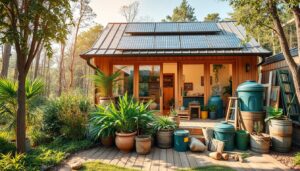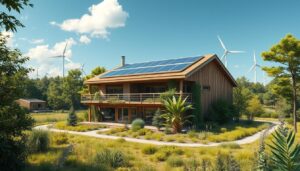Did you know a slow drip from a leaky faucet can waste up to 170 gallons of water each day? With more people and climate changes making fresh water scarce, saving water at home is key. By using a few simple tips, you can save this vital resource and cut your bills too.
Using eco-friendly ways to save water helps fight waste. Everyone can help by fixing leaks, using appliances wisely, or changing daily habits. Join the effort for sustainable living and make a big difference in your water use.
Key Takeaways
- Leaky faucets can waste a lot of water and money.
- Washing full loads saves up to 45 gallons per cycle.
- Low-volume toilets use much less water than old ones.
- Short showers save a lot of water each month.
- Using native plants cuts down on water for landscaping.
Understanding the Importance of Water Conservation
Water is crucial for our daily lives, making saving it a top priority. We see the need for water conservation when we realize it’s a limited resource. Only 3% of the Earth’s water is fresh, and only 1.2% is safe for drinking. This shows us the importance of using water wisely at home.
Why Water is a Precious Resource
In countries with lots of water, it’s easy to think we have enough. But, 2 billion people worldwide don’t have access to safe water, says UNESCO. The average American uses 7,786 liters of water daily, which is a lot. A family can waste 180 gallons a week, which could be used for important tasks.
Using grey water recycling can save up to 70 liters of clean water. This shows us smart ways to save water at home.
How Water Scarcity Affects Communities
Water shortages hit communities hard, causing economic problems, food shortages, and conflicts. Already, 40% of people globally face water shortages. By 2050, one in four people will struggle to find enough water.
This leads to health issues, like diseases from bad sanitation, and harm to nature. Protecting our water sources is key to solving these problems.
| Impact of Water Scarcity | Statistics |
|---|---|
| Global Population Affected | 40% experience water shortages |
| Future Projections | 1 in 4 people affected by 2050 |
| Annual Deaths Due to Water Issues | 1 million from water-related diseases |
| Lack of Safe Drinking Water | 2 billion people |
| Impact on Food Production | Food shortages driven by water scarcity |
Common Household Water Usage
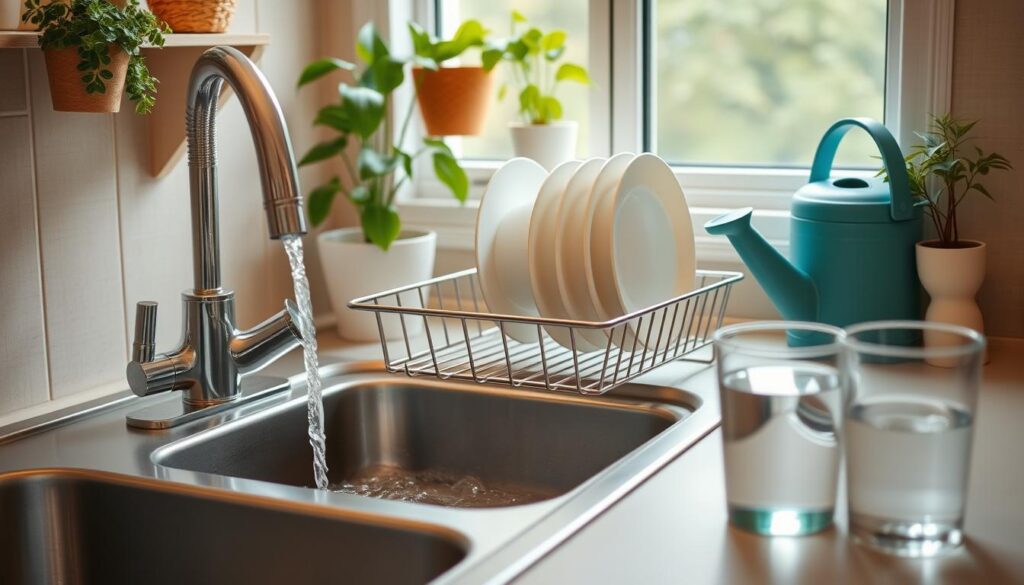
You understand how we use to reduce water usage at home. You might ask, where does your water go? Many things use water every day, like drinking, cooking, and even watering the garden. Let’s look at the main places water is used and how our lifestyle affects it.
Where Does Your Water Go?
Water is vital for many household tasks. Here’s a look at how much water we use for different activities:
| Activity | Water Usage (Gallons) |
|---|---|
| Showering (10 min with standard showerhead) | 25 |
| Bathing | 35-50 |
| Toilet Flush (traditional) | 3.5-8 |
| Dishwasher Use | 7.9 |
| Outdoor (gardening, etc.) | 70-80 (Varies) |
By making smart choices, we can use less water. For example, low-flow showerheads save about 12.5 gallons per shorter shower. Checking how we use water helps us make better choices.
The Impact of Lifestyle on Water Consumption
Our daily choices affect how much water we use. Making smart changes can help.
- Using an efficient washing machine
- Implementing drip irrigation in the garden
- Collecting rain for watering
These changes can cut your water bill and help the environment. High-efficiency washers and drip irrigation use less water than old methods. Thinking about these changes helps us use water better and protect our water resources.
Water Conservation at Home
Sustainable water usage at home is key for saving money. By using simple techniques, you can lower your water use. This helps you live more sustainably and cuts your bills. Knowing where most water is used enables you to save more effectively.
Implementing Simple Water-Saving Techniques
Here are some easy ways to save water daily:
- Turn off the faucet while brushing your teeth to save up to 4 gallons of water each day.
- Consider installing a WaterSense® labeled shower head which can save at least 20% of water.
- Shorten your showers by just 2 minutes to conserve up to 150 gallons of water per month.
- Regularly check for leaks in your toilets and sinks; a simple test can prevent waste.
- Purchase an ENERGY STAR® labeled dishwasher to further cut down on your water usage.
Identifying Areas of High Water Usage
To save more water, focus on high-use areas in your home.
| Area | Typical Usage (gallons) | Conservation Tips |
|---|---|---|
| Bathrooms | 10-25 (per shower) | Use low-flow fixtures and consider WaterSense® products. |
| Kitchen | 20 (per dishwasher load) | Choose water-efficient appliances and scrape dishes instead of rinsing. |
| Laundry Room | 15-40 (per load) | Only wash full loads and use energy-saving washing machines. |
| Outdoor | 9 billion (daily for irrigation) | Install a smart irrigation controller for precision watering. |
By focusing on these areas, you can greatly reduce your water use. This supports important efforts in water-saving practices. Simple changes can make a big difference and protect water for the future.
Tips for Saving Water in the Kitchen
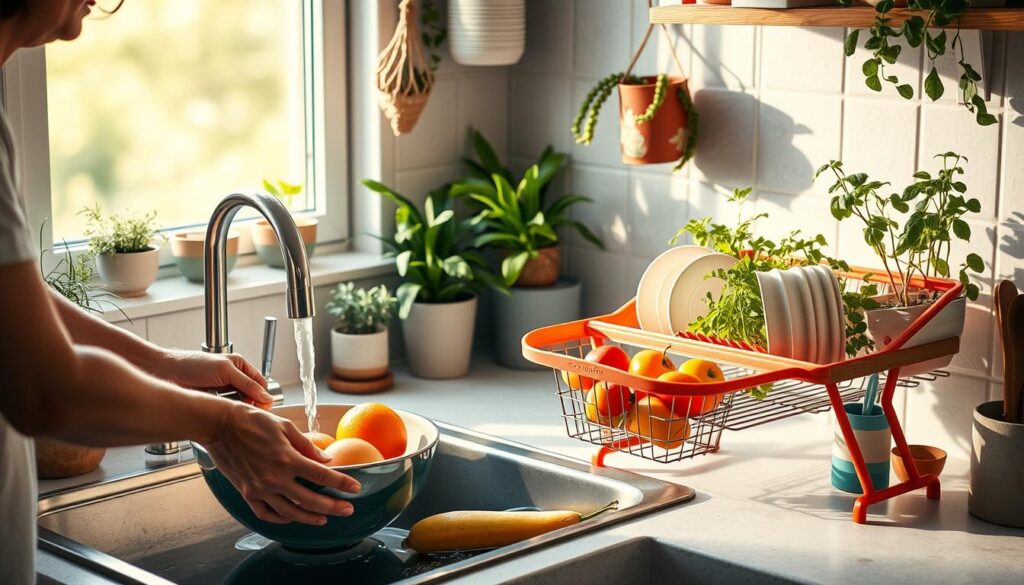
Using smart tips for saving water in your kitchen can really cut down on water use. By following these steps, you help save this vital resource. You’ll also keep your kitchen running smoothly and efficiently. Here are ways to make your kitchen more eco-friendly with water conservation.
Efficient Dishwashing Practices
Begin by waiting for a full dishwasher load before starting. Dishwashers use between four and six gallons per load, much less than hand washing. Also, reuse dishwater for plants or save pasta water for cooking later to reduce waste.
- Turn off the tap while washing dishes to save water.
- Repair leaky faucets right away to stop wasting water.
- Compost food scraps instead of using the disposal to save water.
Using Appliances Wisely
Choosing appliances that use less water is a great way to update your kitchen. Look for eco-friendly water-saving products with a high Water Efficiency Labelling Scheme (WELS) rating. These appliances use less water but still work well.
Installing low-flow taps can also cut down on water use. These taps work just as well but use less water.
Small changes, like using cold water for cooking and turning off the tap while brushing teeth, add up. These actions help save a lot of water and support sustainability.
Efficient Water Use in the Bathroom
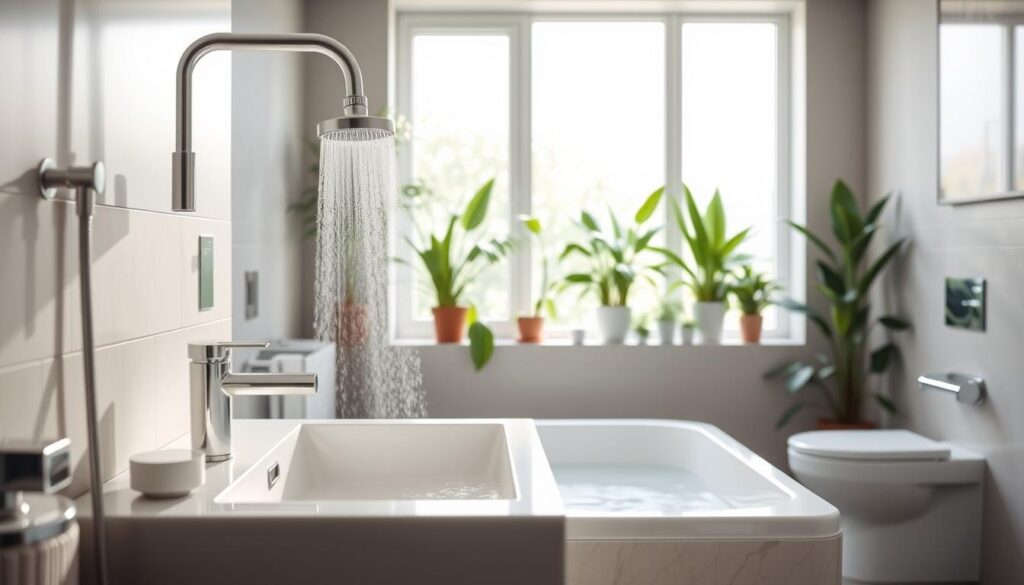
The bathroom is a key spot for saving water with little effort. Making a few changes can greatly reduce water use. This helps save money and resources by changing habits and using better fixtures.
Shortening Showers and Their Benefits
Shorter showers help save water and fit into your daily life. Cutting down shower time means using less water each time. Using a water-efficient showerhead lets you enjoy your shower without wasting water.
A standard shower uses up to 3 gallons a minute. Just cutting a few minutes off your shower can save a lot of water.
Fixing Leaky Faucets and Toilets
Fixing leaks in faucets and toilets is key to saving water. A small leak can waste up to 170 gallons a day. Toilets often leak without you knowing, wasting over 5,000 gallons a month.
Installing low-flow toilets uses only 1.28 gallons per flush. This saves water and helps with your water-saving goals.
These changes can lower your water bill and help the environment.
| Water Usage Area | Efficient Alternative | Water Savings |
|---|---|---|
| Showers | Water-efficient showerheads | 3 gallons/minute saved |
| Faucets | Faucet aerators | 1 gallon/minute reduced |
| Toilets | Modern low-flow models | 1.28 gallons/flush |
Reducing Water Usage in the Laundry Room
Reducing water usage in the laundry room is key to sustainable living. A lot of water is used here, so it’s important to use less. By picking the right load sizes and using efficient washing machines, you can cut down your water use a lot.
Optimal Load Sizes for Washing Machines
Choosing the right load size for your washing machine helps save water. It’s best to wash a full load. Standard machines use about 20 gallons per load, but ENERGY STAR machines use only 14 gallons.
By washing all your laundry together, you can save up to 26,000 liters of water each year.
Water-Efficient Washing Machines
Buying water-efficient washing machines is a big help. ENERGY STAR machines use 40% less water and 25% less energy. They save water and cut down on bills too.
If every U.S. home got an ENERGY STAR washer, it would save over 19 billion pounds of greenhouse gases a year.
| Washer Type | Water Used per Load | Annual Water Savings |
|---|---|---|
| Standard Washer | 20 gallons | N/A |
| ENERGY STAR Washer | 14 gallons | Up to 1,800 gallons |
Using less detergent and cold water also helps save water over time. Switching to high-efficiency machines is good for the planet and makes your clothes cleaner. It also helps you use water wisely at home.
Eco-Friendly Water Conservation Practices
Using water-saving practices helps save water and helps the environment. You can help by choosing the right plants for your yard and managing waste better. Using plants native to your area makes your garden look good and helps local ecosystems. It also means you use less water. Composting your waste helps the planet too by cutting down on landfill waste and supporting sustainable living.
Using Native Plants in Landscaping
Choosing native plants for your garden helps local wildlife and cuts down on watering needs. These plants are made for your local climate and soil, so they don’t need much water. This is good for saving water and making your garden easier to take care of.
- Reduced watering needs
- Lower maintenance requirements
- Attraction of local pollinators
Native plants make your garden stronger and help more kinds of life. They help your local environment and use less water.
Composting Instead of Disposing
Composting is a great way to deal with kitchen waste and save water. It sends less waste to landfills and makes soil better when used in gardens. Composting means less waste in landfills and less need for chemical fertilizers, which saves water.
| Benefit | Impact |
|---|---|
| Reduces landfill waste | Decreases greenhouse gas emissions |
| Improves soil health | Enhances water retention capabilities |
| Provides organic fertilizer | Reduces dependency on synthetic fertilizers |
| Encourages recycling | Promotes sustainability |
By composting, you help save water and make your garden better. Doing these things every day can make your community use water better.
Outdoor Water Conservation Techniques
Using outdoor water conservation techniques is key to a sustainable environment. You can cut down on home water use by watering your lawn and garden wisely. Early morning watering helps reduce water loss and supports plant growth.
Smart Watering Strategies for Your Lawn
When you water your lawn, timing is everything for saving water. Water between 3 and 6 a.m. for better absorption and less evaporation. This period is cooler, making it ideal for watering.
Up to 30 percent of water can evaporate quickly on hot days. Using a drip irrigation system can help. It uses 20 to 50 percent less water than traditional methods. This is great for gardens, vegetable plots, and plants in containers.
- Mulch around trees and shrubs with a three to four-inch layer to retain moisture.
- Regularly check and repair leaks in irrigation systems to prevent water wastage.
- Utilize drought-resistant ground cover instead of traditional grass lawns, saving substantial water resources.
Harvesting Rainwater for Utilization
Harvesting rainwater is another way to reduce water use at home. You can use barrels to collect rainwater for irrigation. This cuts down on the need for municipal water.
Systems that capture greywater are similar to rainwater harvesting. They help maintain your landscaping without using treated water. These steps save water and support a healthier ecosystem. By using outdoor water conservation techniques, you help manage our valuable water resources.
Monitoring and Managing Water Use
Monitoring water use is crucial for saving water at home. By looking closely at your water bill, you can learn a lot about how much water your home uses. This knowledge helps you find ways to use less water and be more efficient.
Reading Your Water Bill Effectively
It might seem hard to read your water bill, but it’s very important. Your bill shows how many gallons you used and if your usage has changed. Here’s what to look for:
- Monthly usage: This shows how much water your home used last month.
- Comparison with past usage: Seeing how this month compares to others can help spot problems like leaks or too much use.
- Charges and rates: Knowing the different rates can help you use water smarter to save money.
Assessing Your Home’s Water Usage with Audits
Regularly checking your water usage helps find leaks and understand how much you use. Here’s a step-by-step guide:
- Look for leaks: Check faucets, toilets, and sprinklers. A leaky toilet can waste up to 200 gallons a day.
- Review your landscaping: Using native plants can cut down on the water you need.
- Use efficient fixtures: Low-flow showerheads and faucets save a lot of water.
- Watch your outdoor use: Use rain barrels and cover pools to save water.
Being active with your water usage leads to better habits and less waste. Reading your water bill and doing audits helps you understand and support sustainable living.
Community Involvement in Water Conservation
Your actions can greatly help save water in your community. By teaching your neighbors how to save water, you build a united front. This education leads to better habits and encourages everyone to save water every day.
Sharing Your Knowledge of Water-Saving
Talking about saving water in your neighborhood is key. Organize workshops to teach people how to save water. This includes:
- Installing aerators in faucets.
- Using low-flow showerheads.
- Switching to WaterSense-rated appliances.
Sharing these tips makes people think differently about their water use. Look at Cherry Creek 3 in Colorado for an example. They cut their water use from 37 million gallons to under 22 million gallons from 2009 to 2014. This shows what we can achieve together.
Getting Involved in Local Initiatives
Joining local projects helps build community and promotes green living. Look for projects that teach people to use water wisely. They might include:
- Educating residents about efficient water use.
- Changing yards with plants that need less water.
- Hosting events to teach outdoor water saving.
These projects can make a big difference. In Cherry Creek 3, using native flowers instead of grass cut water use by 40%. This effort helped 250 homes save water.
Creating a network of neighbors who care about saving water is powerful. Working together, we can make our community more sustainable. Your actions can start a movement and encourage others to help too.
Conclusion
Efficient water use in the home is essential, not just a trend. It helps save money on bills and protects our planet’s water. By fixing leaks and using efficient appliances, we can save a lot of water.
Only 3% of Earth’s water is safe for drinking. This shows how urgent it is to save water. By using low-flow fixtures and rain barrels, we help make sure future generations have enough clean water.
Your efforts to save water make your home more efficient and help protect our planet. Start using water-saving strategies now. These actions will fight water scarcity and make the environment healthier for everyone.
FAQ
Why is water conservation at home important?
Saving water at home is key for the planet, cuts down on bills, and keeps water for the future. Simple steps can make a big difference in how we use water.
What are some easy tips for saving water in the household?
Easy ways to save water include turning off the faucet while brushing teeth, using fixtures that use less water, fixing leaks fast, and only running full loads in washing machines and dishwashers. These steps can really help cut down on water use.
How can I identify high water usage areas in my home?
Look at your water bill, do a home water audit, and check how often you use water in places like bathrooms, kitchens, and gardens. This helps you focus on saving water where it’s used the most.
What are effective water-saving practices for the kitchen?
Save water in the kitchen by washing fruits and veggies in a bowl, only running the dishwasher when full, and choosing eco-friendly appliances. These actions can greatly reduce your water use.
How can I conserve water in the bathroom?
Conserve bathroom water by taking shorter showers, using less water showerheads and faucets, and fixing leaks right away. Cutting down on shower time also saves money and water.
What are the benefits of using water-efficient washing machines?
Water-efficient washing machines use less water per cycle, lowering your water and energy bills. Running full loads helps you meet your laundry needs without wasting water.
How can landscaping practices help with water conservation?
Using plants that need less water in your yard cuts down on the need for watering. Composting kitchen waste also helps save water and is good for the planet.
What are some outdoor water conservation techniques I should consider?
Try smart watering like drip irrigation and watering your lawn early in the morning. Collecting rainwater for your garden and outdoor projects also helps use less municipal water.
How can I monitor and manage my water usage effectively?
Keep an eye on your water bills to spot trends, do water audits to find leaks, and set goals to use less. Knowing your habits helps you use water better and find ways to improve.
How can my community support water conservation efforts?
Communities can help by sharing tips on saving water, joining local programs, and working together on projects. Working with neighbors creates a culture of saving resources and boosts the impact of your efforts.
Source Links
- https://www.homewater.com/blog/how-to-save-water-at-home-14-ways-you-can-do-your-part
- https://southcentralwaternd.com/conservation-tips-and-prepare-home-for-winter
- https://learn.eartheasy.com/guides/45-ways-to-conserve-water-in-the-home-and-yard/
- https://www.homewater.com/blog/water-conservation-why-its-important
- https://earth.org/understanding-the-importance-of-water-conservation/
- https://www.magnushomeproducts.com/blogs/inspired-living/practical-ways-to-save-water-at-home?srsltid=AfmBOooRTmfxsz9M97U02mJIAYnfS89tp0wJyH4Iu07kKsvrrMLrx2J9
- https://extension.colostate.edu/docs/pubs/consumer/xcm219.pdf
- https://www.srpnet.com/grid-water-management/water-conservation/saving-water-at-home
- https://chariotenergy.com/blog/ways-to-conserve-water/
- https://smartwateronline.com/news/how-to-save-water-in-the-kitchen?srsltid=AfmBOoppI1p3m-hAlpK59_yYJShcHVEdK4e73T97hUcTcBQnkruYtNMB
- https://zerowastechef.com/2021/05/19/16-ways-conserve-water-kitchen-diet/
- https://fairvieworegon.gov/492/Saving-Water-Indoors
- https://www.saws.org/conservation/your-role-in-conservation/water-saving-tips/
- https://www.nps.gov/articles/laundry.htm
- https://www.leadhousehold.co.za/latest-news/ten-tips-save-water-domestic-laundry/
- https://www.1tomplumber.com/how-to-save-water-in-your-laundry-room/
- https://www.culligannation.com/10-ways-to-conserve-water-sustainable-living
- https://davidsuzuki.org/living-green/make-every-drop-count-water-conservation-tips/
- https://basq.livelarq.com/sustainability/32-ways-to-conserve-water-at-home/
- https://www.mansfieldtexas.gov/1907/Water-Conservation-Tips-and-Tricks
- https://www.asla.org/watersavingtips.aspx
- https://www.myutility.us/corixtexas/water-smart/conservation
- https://portal.ct.gov/deep/water/water-quantity/tips-for-conserving-water
- https://earth911.com/inspire/encourage-water-conservation/
- https://www.gov.nl.ca/ecc/waterres/waste/water-conservation/
- https://brazos.org/About-Us/Education/Water-School/ArticleID/346/Why-should-I-conserve-water
- https://www.activesustainability.com/water/save-water-at-home/
- https://watercareservices.org/5-ways-to-conserve-water-at-home-and-school/



